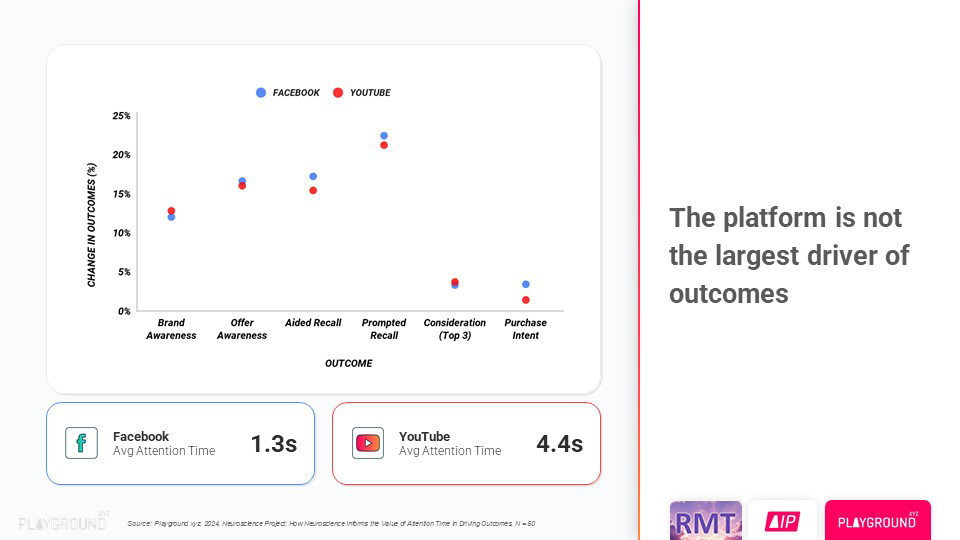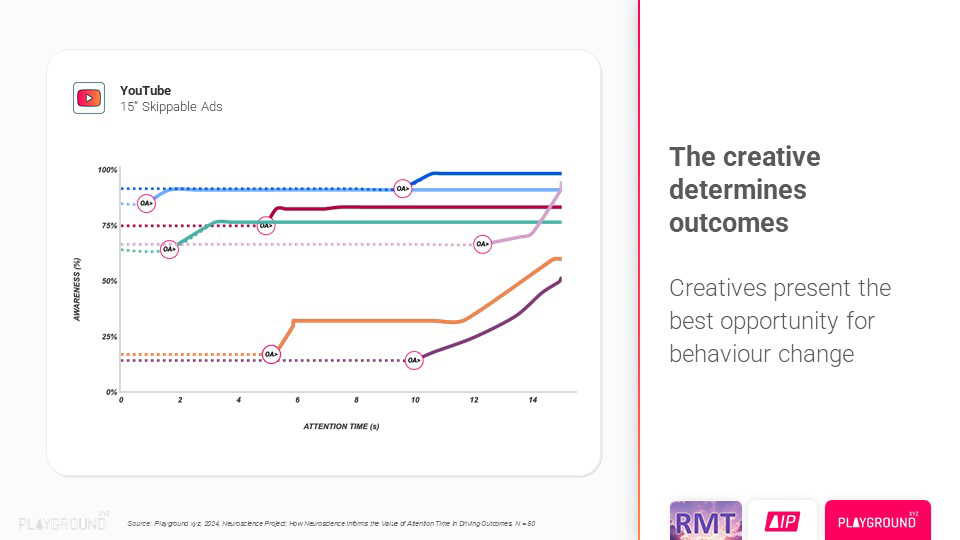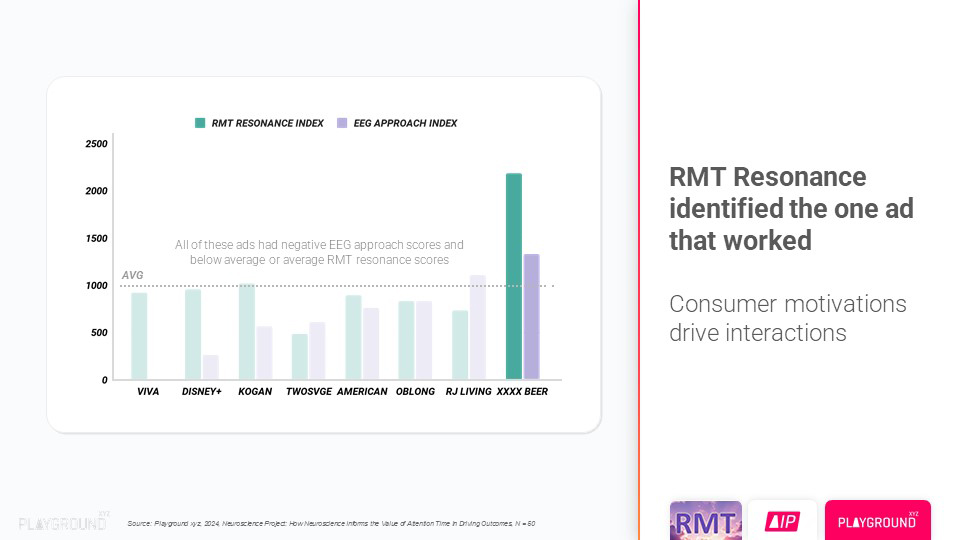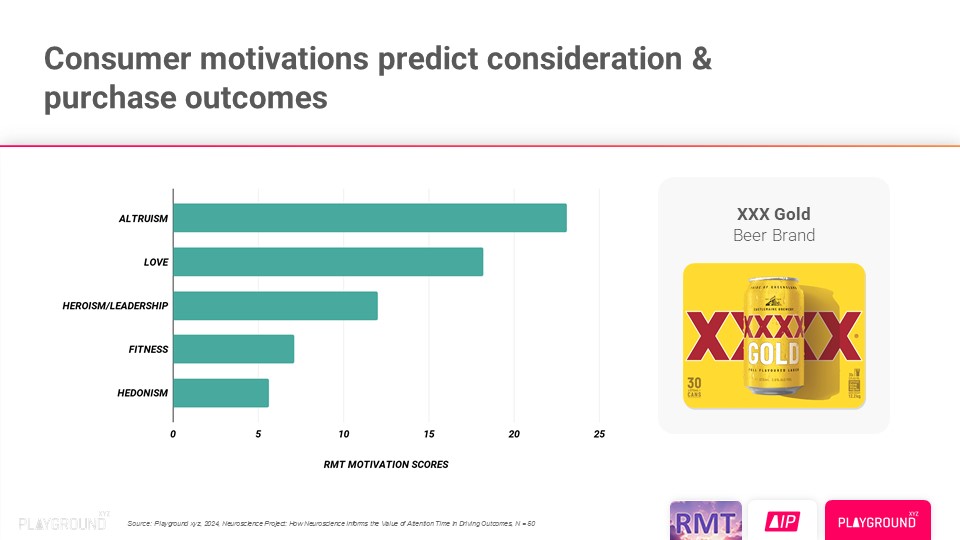Neuro Study: Greatly Improve Attention’s Predictivity of Sales Results by Adding RMT Motivations

At the Advertising Research Foundation (ARF) AUDIENCExSCIENCE 2024 Conference, Playground xyz Chief Scientist Shannon Bosshard and myself from RMT co-presented the results of two studies, a brand lift study and a neuro study. This was methodological research – research on research – to identify opportunities for making advertising attention measurement more predictive of sales. Earlier studies show that eyetracking plus machine learning identify platform effects, enabling filtering out of least-attentive environments. The validations of this general methodology show ad recall and other upper funnel positive effects, but less compelling improvement results at bottom funnel.
The flash results of the FOX Wharton Bill Harvey Consulting (BHC) neuro study shown at the same ARF conference explain why this is so. Three EEG metrics have extremely high predictivity of sales – Approach (Brand Attraction), memory encoding, and Synchrony (all brains have same pattern at same instant while viewing ad). All three of these measures take time to form and solidify, from 5 to 20 seconds to influence sales behavior change. Most digital ad exposure, even with the use of “eyetracking norm filtration by platform”, are 1-2 seconds. YouTube 4.5 seconds. Not enough to move the sales needle.
Shannon presented the following slide, summarizing the results of the brand lift study. As you can see, the impact of Facebook and YouTube are much lower on both the Consideration and Purchase Intent metrics than they are on ad recall, brand awareness, and offer recall.

Also, although YouTube average attention levels were 3.4X higher than Facebook, the two platforms yielded almost identical outcomes on every measure. Shannon concludes that these patterns strongly suggest that filtering based only on attention is an oversimplification and sub-optimizing. And that the creative and its motivational resonance with the user must have much stronger effects than the platform choice. True optimization of sales effect would have to include these two variables as well as attention.
The Playground xyz study also found that each piece of creative has its own number of seconds of attention required to generate brand awareness, with most ads containing sweet spots where brand awareness shoots up. Most of these sweet spots are more than five seconds into the ad, in other words, very unlikely to be reached in digital.

RMT generally develops a motivational profile for a person or a household by analysis of months of browser or set top box data. That was beyond scope in this study, and so RMT developed a sketch of a person’s motivations based only on ten or fewer favorite television series. Yet even this decimated method predicted the one ad that this first subject was moved by, in terms of brain Approach signals.

What is the reason RMT is able to predict brain and sales responses? (As validated five times before in terms of sales, by Nielsen NCS, Simmons, Neustar, 605, and the ARF Cognition Council.)
It’s because AI Machine Learning (ML) was used to distill the 265 variables that can be content coded as metadata onto ads, media content, and people, out of the over ten thousand psychological words in the English language. This was by means of a field experiment with set-top box big data and a customized program recommender. The output measure being optimized was the conversion rate from a never-saw to a three-out-of-four-episodes loyal viewer of a series. With 1562 variables that conversion rate was 2-3 percent, and with the 265 optimal variables it was 18%.
The basic RMT measure is resonance, and there are two kinds:
- Between the ad and the person
- Between the ad and the context
The preferred implementation is to use both together. In the Shannon pilot, the ad-person resonance was used, without the ad-context measure, and the results would have likely been even stronger if both approaches had been used.

Playground xyz and RMT continue to discuss next steps for expanding this work together.
Zooming back, although attention has been the focus of the industry for the past few years, and attention plays an essential role in the advertising process, it is itself caused by motivations (see Appendix below). We notice and pay attention to stimuli that are relevant to our motivations. If one is hoping for a single simple silver bullet, RMT would be a better filtering strategy than attention, because resonance will cause attention. However, because there is a “religious” (i.e. unsupported by science) movement to lower marketing investments while increasing brand growth, brands need to use every trick in the trade, so we recommend the most sophisticated approach to attention plus RMT resonance, which being content coding is the most scalable and affordable predictor of sales effects.
Appendix:
There is ample scientific proof that motivations cause attention. For example, in his landmark contribution Attention, Dr. Wayne Wu uses the word “goals” to describe the effect of pre-existing motivations on the process of the consumer selecting what to pay attention to: “Once there is goal-directed biasing of this sort, attention ‘emerges’ or ‘is realized’ in competition when the winner takes all of the spiking resources.” (Page 60)
The National Institutes of Health (NIH) states it this way:
“At any point in time, adaptive behavior necessitates the selection of the most relevant information at hand. Visual attention is a key determinant of the selection of items that will ultimately impact behavior. Behavior is also shaped by motivational factors, which are often closely tied to reward and punishment. A growing body of evidence indicates that attention and motivation are intimately tied. Evidence for attention–motivation interactions is suggested by findings that stimuli carrying motivational significance preferentially engage attention, including stimuli with positive emotional valence (Anderson, 2005; LaBar et al., 2001; Mogg et al., 1998, 2003; Most et al., 2007.”
A March 2014 paper in Frontiers of Psychology, “The role of intrinsic motivations in attention allocation and shifting” reports that “intrinsic motivations directly affect the allocation of attentional resources.”
Posted at MediaVillage through the Thought Leadership self-publishing platform.
Click the social buttons to share this story with colleagues and friends.
The opinions expressed here are the author's views and do not necessarily represent the views of MediaVillage.org/MyersBizNet.


